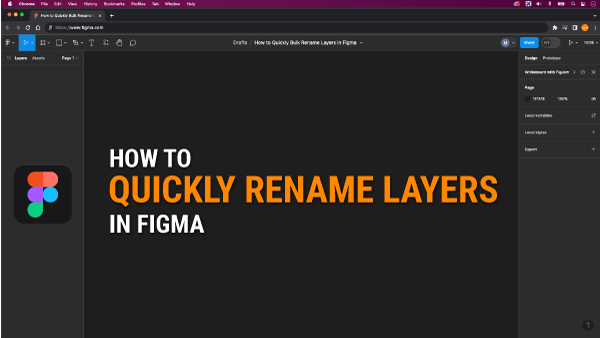We didn’t cover an essential topic in our previous video: the significance of layer naming. But why is naming layers such a crucial practice? Whether you’re collaborating with others or needing to make adjustments to your design files, it can significantly impact your workflow.
Layer naming is a straightforward yet potent technique that can elevate your design process, foster collaboration, and simplify maintenance. It’s a habit worth embracing when working with design tools. Not only does it save you time and frustration, but it also enhances the accessibility and comprehensibility of your designs for your teammates.
Optimizing Layer Names: A Key Design Practice
The quickest way to rename a layer is by double-clicking its name in the Layers panel. This action highlights the text, allowing you to input a new name effortlessly.
Alternatively, you can right-click on the layer in either the canvas or the Layers panel to open a context menu. There, you can choose “Rename” or “Edit Name” to modify the layer’s name.
Bulk Renaming Made Easy
To streamline the process, ensure the layers are correctly ordered.
- Begin by navigating to the Layers panel on the left-hand side of your screen.
- Start by selecting the top layer in the panel.
- While holding down the ‘Shift’ key, continue to click on the bottom layer. This action will automatically select all layers in between, making it a quick and efficient process.
- If you happen to come across a layer that shouldn’t be part of the bulk renaming process, don’t worry. Just hold down the ‘Command’ key on a Mac or the ‘Control’ key on a PC, and click on the specific layer to unselect it from the group.
- Once you’ve ensured that the selected layers are the ones you intend to rename in bulk, it’s time to use a convenient keyboard shortcut. For Mac users, you can press ‘Command + R,’ while PC users can use ‘Control + R’ to access the ‘Rename Selection’ feature.
This method should help streamline the process for you.
A dialog box will appear, allowing you to rename the layers. For now, leave the ‘Match (optional)’ field untouched, but you can return to it later. Rename your layers as needed. Avoid clicking on ‘Current Name’ if you want to replace the previous name. You can also add numerical orders from either the top or bottom. After making your selections, click ‘Rename,’ and all the chosen layers will be swiftly updated.
Editing Renamed Layers
If you need to modify the layers you renamed earlier, you can revisit the ‘Rename Selection’ function. On a Mac, use ‘Command R,’ and on a PC, it’s ‘Control R.’ This time, make use of the ‘Match’ feature, similar to ‘Find and Replace’ in other applications. For example, if you want to change ‘Feature’ to ‘Home Gallery,’ input ‘Feature’ in the first field and ‘Home’ (without a space) in the second field. Once your settings are configured, click ‘Rename,’ and the layers will be updated with the new names.
So there you have it. Managing multiple identically named layers can be a headache, but taking the time to label your layers properly streamlines the process and makes your design files more shareable and adaptable for future changes, simplifying your life and improving your workflow.
